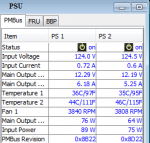My whole rack runs around 1,100W and will jump to 1,600-1,700W if I really hammer it. That includes:
FreeNAS server (in my sig)
3x 16-core vSphere nodes
2x 4-core domain controllers
1x 4-core pfSense box
2x gigabit switches (one PoE, powering 11 IP cameras and 3 wifi APs)
All the various little stuff... cable modem, LTE modem, distribution amp for antenna TV, HDHomeRun boxes for antenna and cable, etc.
That's exactly what I mean by things (watts) add up quickly. :)
I knew your system was not alone in the rack, same as mine. From the power outlet to the rack I have 3 UPS's and each is taking around 15-20 Watts before anything was connected to it.
My pfSense box 1x8 cores Atom C2000 16Gb Ram, 2x120 SSD is burning only 34 Watts. Which is absolutely great, considering that it resides in 1U chassis with dual power supplies.
It's nice when you are able to make machine more power efficient so you can run more machines :)
Just by switching my NAS (signature) old dual 800W PSU with new dual 500W platinum , machine became much quieter and at lest 40W more efficient, so now I can add this 1U DVR dedicated FreeNAS server (39W idle with drives) and keep total power consumption the same.:)
P.S. Your power consumption look to low from what you are describing, are you sure you measure at the tap?:)
Because this section alone :
"FreeNAS server (in my sig)
3x 16-core vSphere nodes
2x 4-core domain controllers"
feels like 1Kw just there. But it is very good if idle around 1100W for what you describe.

